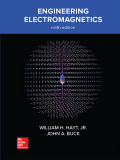
(a)
The reflective phase shift at the front surface of glass for the glass thickness
Answer to Problem 12.18P
The reflective phase shift at the front surface of glass is
Explanation of Solution
Given:
Refractive index of glass
Glass thickness
Concept Used:
Calculate reflection coefficient
Use the value of input impedance as
Then, calculate phase by using the formula
Calculation:
Now there are three regions where region first is air, region two is the glass and the region three is perfectly conductor.
With the third region as the perfect conductor
Now, the input impedance for the structure as,
Then the reflection coefficient will be as below:
The reflective phase can be calculated as below:
We have
For
And so, we have,
(b)
The reflective phase shift at the front surface of glass for the glass thickness
Answer to Problem 12.18P
The reflective phase shift at the front surface of glass is
Explanation of Solution
Given:
Refractive index of glass
glass thickness
Concept Used:
Calculate reflection coefficient
Use the value of input impedance as
Then, calculate phase by using the formula
Calculation:
Now there are three regions where region first is air, region two is the glass and the region three is perfectly conductor.
With the third region as the perfect conductor
Now the input impedance for the structure as,
Then the reflection coefficient will be as below:
The reflective phase can be calculated as below: -
We have
For
And so, we have,
(c)
The reflective phase shift at the front surface of glass for the glass thickness
Answer to Problem 12.18P
The reflective phase shift at the front surface of glass is
Explanation of Solution
Given:
Refractive index of glass
glass thickness
Concept Used:
Calculate reflection coefficient
Use the value of input impedance as
Then, calculate phase by using the formula
Calculation:
Now there are three regions where region first is air, region two is the glass and the region three is perfectly conductor.
With the third region as the perfect conductor
Now the input impedance for the structure as,
Then the reflection coefficient will be as below: -
The reflective phase can be calculated as below:
We have
For
And so, we have,
Want to see more full solutions like this?
Chapter 12 Solutions
Engineering Electromagnetics
- Can you show how this answer was found:arrow_forwardQ1 [2 point] Perform 13+10 in the following Adder- Subtractor: A= |B= A3 B3 IB2 B1 A0 BO FAH FAH FAH FA M CO Q2 [2 point] Perform 13-10 in the following Adder- Subtractor: A= B= A3 B3 A2 B2 A1 B1 A0 BO A = = BC= AB FA FA FA FA M COarrow_forwardMatlab Homework (20ps) A BFSK signal is transmitted through a channel with AWGN. Generate similar BFSK received signal plots as shown on next page. (20 pts) BFSK for eb-1 and npower=0.01 with 500 samples BFSK for eb=1 and npower=0.1 with 500 samples 2.5 2.5 2 1.5 1 0.5 0 -0.5 -1 2 1.5 1 0.5 0 0.5 -1 -1.5 1.5 -1.5 -1 -0.5 0 0.5 1 1.5 2 2.5 -1.5 -1 -0.5 0 0.5 1 1.5 2 2.5arrow_forward
- Can you show how this answer was found?arrow_forward1. You are to design a 9-volt battery operated baseband PAM communication system that must last great than 10 years without replacing the batteries. The application requires a BER of <10^-4 and a data rate of 200bps. The channel can be modeled as AWGN with a noise power spectral density of 10^-9 W/Hz and a channel loss of 10 dB. (a) Estimate the required capacity of the batteries. (The battery life (hours) is equal to the battery volts times of the battery capacity (Amps* hours) divided by the total load (Watts)) and (b) Can you easily find this battery? If not, what would you suggest be done?arrow_forward3. You are on a design team tasked to design a system of remote sensors that use PAM. Here is what the team knows/assumptions: The remote sensor will use a single AA battery required to power the sensors. The system has a bandwidth of 2KHz and requires a data rate of 12 Kbps and a BER of less than 1*10^-4. The typical channel has maximum losses of 35 dB and a noise power spectral density is 10^-9 W/Hz. Your boss assigns you with the task of estimating how long the battery will last.arrow_forward
- 2. The noise power (in watts) measured in a baseband PAM communication channel is 230*10^-6 Watts. The transmitter output power is 600 mW and has a data rate of 300 Kbps. The channel bandwidth is 100 KHz with losses that can be modeled as 0.5dB/meter. The application requires a BER ofarrow_forwardQ27arrow_forwardQ25arrow_forwardarrow_back_iosSEE MORE QUESTIONSarrow_forward_ios
 Introductory Circuit Analysis (13th Edition)Electrical EngineeringISBN:9780133923605Author:Robert L. BoylestadPublisher:PEARSON
Introductory Circuit Analysis (13th Edition)Electrical EngineeringISBN:9780133923605Author:Robert L. BoylestadPublisher:PEARSON Delmar's Standard Textbook Of ElectricityElectrical EngineeringISBN:9781337900348Author:Stephen L. HermanPublisher:Cengage Learning
Delmar's Standard Textbook Of ElectricityElectrical EngineeringISBN:9781337900348Author:Stephen L. HermanPublisher:Cengage Learning Programmable Logic ControllersElectrical EngineeringISBN:9780073373843Author:Frank D. PetruzellaPublisher:McGraw-Hill Education
Programmable Logic ControllersElectrical EngineeringISBN:9780073373843Author:Frank D. PetruzellaPublisher:McGraw-Hill Education Fundamentals of Electric CircuitsElectrical EngineeringISBN:9780078028229Author:Charles K Alexander, Matthew SadikuPublisher:McGraw-Hill Education
Fundamentals of Electric CircuitsElectrical EngineeringISBN:9780078028229Author:Charles K Alexander, Matthew SadikuPublisher:McGraw-Hill Education Electric Circuits. (11th Edition)Electrical EngineeringISBN:9780134746968Author:James W. Nilsson, Susan RiedelPublisher:PEARSON
Electric Circuits. (11th Edition)Electrical EngineeringISBN:9780134746968Author:James W. Nilsson, Susan RiedelPublisher:PEARSON Engineering ElectromagneticsElectrical EngineeringISBN:9780078028151Author:Hayt, William H. (william Hart), Jr, BUCK, John A.Publisher:Mcgraw-hill Education,
Engineering ElectromagneticsElectrical EngineeringISBN:9780078028151Author:Hayt, William H. (william Hart), Jr, BUCK, John A.Publisher:Mcgraw-hill Education,





